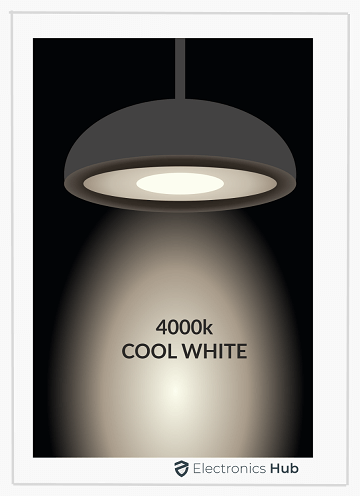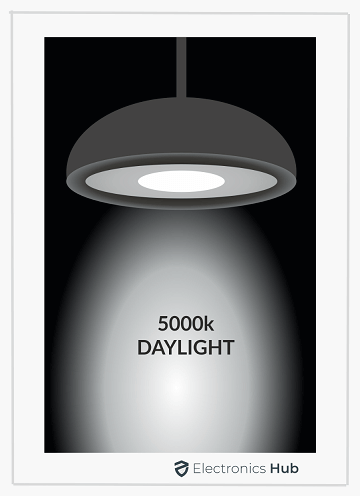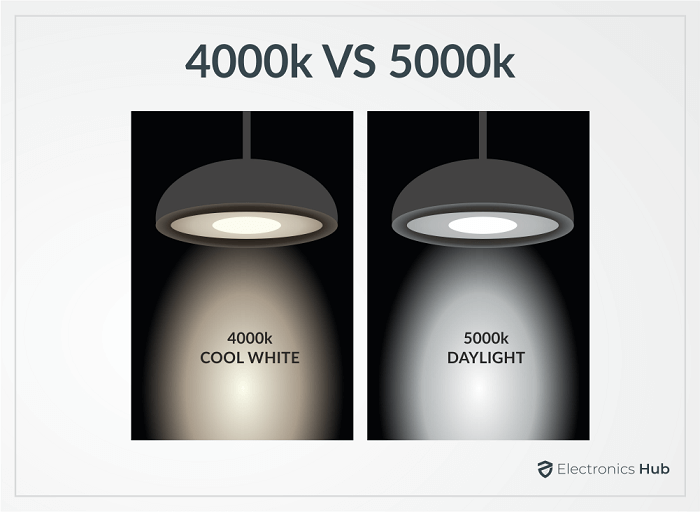LEDs have come a long way in the last couple of decades with significant improvements in terms of reliability, efficiency, size and ruggedness. An important benefit of LEDs is that you can manufacture them to get precisely the right color temperature that suits a variety of needs and applications. Speaking of color temperatures, the 4,000K and 5,000K are two popular values for LED light bulbs. In this guide, we will compare 4,000K vs 5,000K lighting, their target applications and also see which is suitable for home usage.
Outline
ToggleA Brief Note on Color Temperature
At first glance, it might seem weird to combine ‘color’ and ‘temperature’. But not according to Planck’s Black Body Radiations. When we gradually increase the temperature of Planckian black body, it glows initially in red, orange and yellowish white and with increasing temperature the color changes to white and bluish white.
Color Temperature of a light source is a measure of its color with respect to a Black Body at a particular temperature in Kelvin (K). For a White light source, we measure its shade of white light on a temperature scale in Kelvin.
If you take a look at the incandescent light bulb, it typically has a low color temperature of 2800K. But the color temperature of daylight is high, usually 5000K or more.
4000K Color Temperature

4,000K lighting looks very natural and clean, similar to daylight. Hence, we see this color temperature in homes, offices etc. where people need clear lighting without any blue tint.
5000K Color Temperature

At 5,000K, the light appears almost white and as a result, it shows the true colors of objects it falls on. This is the reason you find 5,000K lighting to showcase art.
4000K vs 5000K Lighting – Comparison & Differences

4,000K Lights have a slightly warm color tone while 5,000K Lights have neutral white with a hint of blue. Beyond 5,000K, the blue tint dominates the light and hence, we do not recommend going above 5,000K for reading or working for long hours.
Where to use 4000K vs 5000K Lighting?
The color, type and amount of light in a room has a direct correlation to our brain’s functionality. Color temperature also plays an important role in selecting the lighting for different settings like studying, computer/office, kitchen, art galleries, sports/stadiums etc.
A cool color tone will trigger the release of melatonin, a chemical that helps you relax and makes you sleepy. At the same time, slightly warm color temperature will trigger the release of serotonin, a chemical that boosts your energy levels.
4000K
We will now see some common places where 4000K lighting is very useful.
Kitchen
Whether it is ambient lighting or cabinet lighting in kitchen, you need lighting that fills up the room and at the same time is relaxing and energetic. An LED with 4000K color temperature is perfect for this.
You can easily work with sharp objects such as knives and also enjoy the meal with this lighting.
Offices
Due to its slightly warm tone, a 4000K lighting in office spaces will not only relax the employees but also keeps them alert to have a productive day at work.
Retail Spaces
Imagine you are entering a retail store. The lighting there will clearly impact you as you can clearly see the product and also creates an ambience due to its neutral white with slightly yellowish tint. If the color tone is a tad bit cooler, it might make the customer dim and hazy.
Garages
In a garage, you are surrounded by a lot of tools and machines. You need proper lighting to see the tool/work. The lighting should also be clean and crisp to prevent any mishaps.
5000K
Let us now see some common places where 5000K lighting is useful.
Art Galleries
You can enjoy paintings, sculptures and other art work if the colors are accurate. For this reason, most art galleries and studios use 5000K lighting due to its neutral white color tone.
Showrooms
Automobile showrooms or apparel showrooms also use 5000K lighting to show the real color of the objects. You can clearly see the small and fine details such as the paint work of a car or the stitching of a clothing.
Sports Stadiums
Most fast paced games are shot in high definition to get clear and crisp image. But in order to get accurate or real colors, you need good source of lighting. Hence, most sports stadiums (both indoor and outdoor) use lighting that is close to 5000K color temperature.
Healthcare Institutions
Another important and critical application where the person must have a clear and crisp view of the subject is a hospital. Doctors and other medical professionals must have good lighting to see even the smallest details very clearly. So, places like hospitals, clinics, ambulances, use clean white light from 5000K lighting.
Warehouses
In large warehouse, where workers deal with huge quantities of goods and materials, they need proper lighting to be able to properly see each and every corner of the warehouse and at the same time keep them alert and energetic.
Television Studios and Theaters
Similar to sport stadiums, TV and theatre settings also require clean and natural white light to accurately represent the colors of subjects/objects. While TV studios have cameras that record the play, a theatre is a live setting and hence, proper lighting is very critical to be able to see the performance clearly.
4000K vs 5000K Lights at Home
The difference between a similar brightness 4000K and 5000K lighting is very minimum and in fact when we place two lights each with 4000K and 5000K color temperatures side-by-side, we can hardly tell the difference between them.
But 4000K lighting is slightly yellowish white while 5000K is more of a neutral white with a tiny hint of blue tint.
Due to its slightly warm color tone, we can use 4000K lighting in our living rooms, office rooms and even in kitchens. Coming to 5000K lighting, due to its natural white tone, you can use this lighting in bathrooms, powder rooms etc.
Conclusion
Choosing a proper color temperature for lighting your rooms and offices is very important as it will not only make you see things clearly but also boosts your mood and makes you energetic. There is a long-standing debate over 4000K vs 5000K as to which is the best color temperature. In this guide, we saw the basics of both 4000K as well as 5000K color temperatures and some common application for each temperature. We also saw the areas in home that can benefit from 4000K and 5000K lighting.

